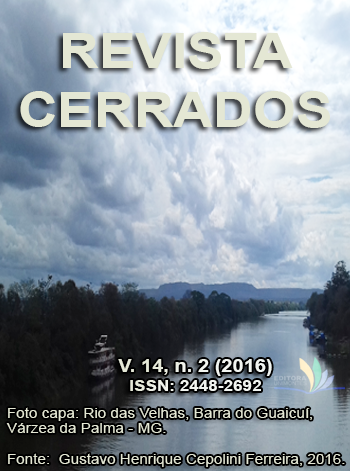Prospective scenario of land use and land cover change at Rio Capivara watershed, municipality of Botucatu, São Paulo State, through dynamic spatial modeling
DOI:
10.22238/rc24482692v14n22016p03a29Keywords:
Weights of Evidence; cellular automata; fuzzy similarity.Abstract
There are several modeling approaches to model land use and land cover changes of a given region, which can, for example, analyze and evaluate several landscape variables based on integrated approaches (i.e. lithology, soil, relief and drainage). The aim of this research was to test the applicability of the Dinamica EGO model for simulating and evaluating scenarios of land use and land cover changes in Capivara river watershed, municipality of Botucatu, São Paulo State, Brazil. Using satellite images (Landsat 5 TM), topographic maps and the softwares ENVI 4.7, ArcGIS 10, Spring 5.1 and Dinamica EGO platform. Firstly, land use and land cover maps for the years 1988, 1997 and 2007 were produced. Secondly, the Dinamica EGO model was calibrated by the analysis and comparing the real and simulated maps, so it was validated by the use of exponential decay method by means of fuzzy similarity index. Finally, using the validated model, a scenario for this watershed for the year 2017 was built. Results showed, from used method, for example, a decrease in grasslands areas and its substitution by reforestation until 2007, that tends to overtake native forest class in the simulated map of 2017. As a conclusion, the Dinamica EGO model can strongly aid in the monitoring of land use and land cover change in the context of watershed. In addition, the proposed methodology can be used to build probabilistic scenarios and, consequently, predict diagnoses and strategies for land use planning.
Downloads
References
AGTERBERG, F. P.; BONHAM-CARTER, G. F. Deriving weights of evidence from geo-science contour maps for the prediction of discrete events. In: INTERNATIONAL SYMPOSIUM AP-COM, 22., 1990, Berlin. Proceedings... Berlin, Tech. University Berlin, v.1, p. 381-395. Disponível em: <http://www.ige.unicamp.br/sdm/doc/documentation/wlr.pdf >. Acesso em: 10 out. 2016.
ALMEIDA, C. M.; Modelagem da dinâmica espacial como uma ferramenta auxiliar ao planejamento: simulação de mudanças de uso da terra em áreas urbanas para as cidades de Bauru e Piracicaba (SP), Brasil. São José dos Campos. 2003. 351 f. Tese de Doutorado, Programa de Pós-Graduação em Sensoriamento Remoto, Instituto Nacional de Pesquisas Espaciais. 2003. Disponível em: <http://www.dpi.inpe.br/gilberto/teses/tese_claudia.pdf >. Acesso em: 28 jan. 2016.
ALMEIDA, C. M.; GLERIANI, J. M. Redes neurais e autômatos celulares como uma plataforma para a simulação de mudanças do uso do solo urbano. In: Almeida, C.M., Câmara, G. & Monteiro, A.M.V. (Org.). Geoinformação em Urbanismo: cidade real x cidade virtual. São Paulo, Oficina de Textos, p. 305-327. 2007.
BATTY, M. Urban modelling: algorithms, calibrations, predictions. Cambridge, Cambridge University Press, 381p. 1976.
BRIASSOULIS, H. Analysis of land use change: theoretical and modeling approache In: Loveridge, S. (Ed.). The Web Book of Regional Science. 2000. Morgantown, Regional Research Institute, West Virginia University. Disponível em: <http://www.rri.wvu.edu/webbook/briassoulis/contents.htm>. Acessoem: 16 fev. 2016.
BONHAM-CARTER, G. F. 1994. Geographic Information systems for geoscientists: modelling with GIS.Ontario, Pergamon Press, 398 p.
CARNEIRO, C. D. R. Viagem virtual ao Aqüífero Guarani em Botucatu (SP): Formações Pirambóia e Botucatu, Bacia do Paraná. Terrae Didática, 3(1): 50-73. Disponível em: <https://www.ige.unicamp.br/terraedidatica/v3/pdf-v3/TD3-50_73.pdf>. Acessoem: 05 fev. 2016.
DELANEZE, M. E. Modelagem dinâmica espacial aplicada na avaliação das mudanças da cobertura da terra no entorno de dutos utilizando autômatos celulares – estudo de caso: Duto Orbel. 2011. 116 f. Dissertação (Mestrado Geociências e Meio Ambiente), Programa de Pós-Graduação em Geociências e Meio Ambiente, Instituto de Geociências e Ciências Exatas, Universidade Estadual Paulista, Rio Claro, 2011. Disponível em: <http://repositorio.unesp.br/handle/11449/92738>. Acesso em: 27 jan. 2016.
DELANEZE, M. E.; RIEDEL, P. S.; MARQUES, M. L.; FERREIRA, M. V. Modelagem Dinâmica Espacial para o monitoramento do crescimento urbano no entorno do Duto ORBEL. Revista Brasileira de Cartografia, 66(3): 473-484. 2014. Disponível em: http://www.lsie.unb.br/rbc/index.php?journal=rbc&page=article&op=view&path%5B%5D=553&path%5B%5D=694>. Acesso em: 14 jan. 2016.
DIAS, L. T.; WALDE, D. H. G.. Modelagem da dinâmica espacial do uso e ocupação do solo na bacia hidrográfica do Lago Paranoá-DF. Revista Brasileira de Cartografia, 65(1): 77-94. 2013 Disponível em: <http://www.lsie.unb.br/rbc/index.php?journal=rbc&page=article&op=view&path%5B%5D=511&path%5B%5D=530>. Acesso em: 08 fev. 2016.
ESRI. Environmental System ResearchInstitute. 2010. ArcMap v. 10. Redlands, ESRI. Programa de computador. 1DVD-ROM.
GONÇALVES, R. M.; CENTENO, T. M.; CANDEIAS, A. L. B. Autômatos Celulares aplicados na modelagem de tendência em imagens multi-temporais. Revista Brasileira de Cartografia, 63(2): 233-241. 2011 Disponível em: <http://www.lsie.unb.br/rbc/index.php?journal=rbc&page=article&op=view&path%5B%5D=375&path%5B%5D=368>. Acessoem: 20 jan. 2016.
HAGEN, A. Fuzzy set approach to assessing similarity of categorical maps. International Journal of Geographical Information Science, 17(3): 235-249. 2003 .Disponível em: <http://dx.doi.org/10.1080/13658810210157822>. Acesso em: 04 fev. 2016.
INSTITUTO BRASILEIRO DE GEOGRAFIA E ESTATÍSTICA. Cidades: Botucatu. Dados do Censo Demográfico, 2014. Disponível em: <http://www.ibge.gov.br/cidadesat/topwindow.htm?1>. Acesso em: 28 out. 2016.
MACEDO, R. C.; ALMEIDA, C. M.; SANTOS, J. R.; RUDORFF, B. F. T. Modelagem dinâmica espacial das alterações de cobertura e uso da terra relacionadas à expansão canavieira. Boletim de Ciências Geodésicas, 19(2): 313-337. 2013. Disponível em: <http://dx.doi.org/10.1590/S1982-21702013000200009 >. Acesso em: 02 fev. 2016.
MAEDA, E. E.; ALMEIDA, C. M.; XIMENES, A. C.; FORMAGGIO, A. R.; SHIMABUKURO, Y. E.; PELLIKKA, P. Dynamic modeling of forest conversion: Simulation of past and future scenarios of rural activities expansion in the fringes of the Xingu National Park, Brazilian Amazon. International Journal of Applied Earth Observation and Geoinformation, 13(3): 435–446. 2011. Disponívelem: <http://dx.doi.org/ 10.1016/j.jag.2010.09.008>. Acesso em: 13 jan. 2016.
MARTINS, D. Clima na região de Botucatu – SP. In: ENCONTRO DE ESTUDOSSOBRE A AGROPECUÁRIA DE BOTUCATU, 1., 1989, Botucatu. Anais...Botucatu, UNESP, v. 1, 1989, p.8-12.
MAS, J. F.; KOLB, M.; PAEGELOW, M.; OLMEDO, M. T. C.; HOUET, T. Inductive pattern-based land use/cover change models: A comparison of four software packages. Environmental Modelling Software,51: 94-111. 2014. Disponível em: <http://dx.doi.org/ 10.1016/j.envsoft.2013.09.010>. Acessoem: 30 jan.2016.
PATHIRANA, A.; DENEKEW, H.B.; VEERBEEK, W.; ZEVENBERGEN, C., Banda, A.T. Impact of urban growth-driven landuse change on microclimate and extreme precipitation -A sensitivity study. Atmospheric Research, 138:59-72. 2014. Disponível em: <http://dx.doi.org/10.1016/j.atmosres.2013.10.005>. Acesso em: 04 fev. 2016.
PÉREZ-VEGA, A.; MAS, J. F.; LIGMANN-ZIELINSKA, A. Comparing two approaches to land use/cover change modeling and their implications for the assessment of biodiversity loss in a deciduous tropical forest. Environmental Modelling & Software, 29(1): 11-23. 2012. Disponível em: <http://dx.doi.org/10.1016/j.envsoft.2011.09.011>. Acesso em: 19 jan. 2016.
PIROLI, E. L. Geoprocessamento na determinação da capacidade e avaliação do uso da terra do município de Botucatu – SP. 2002. 108 f. Tese (Doutorado em Agronomia), Programa de Pós-Graduação em Agronomia, Energia na Agricultura, Faculdade de Ciências Agronômicas, Universidade Estadual Paulista, Botucatu, 2002. Disponível em: <http://repositorio.unesp.br/handle/11449/101875>. Acesso em: 30 jan. 2016.
PISANI, R. J.; Modelagem espacial dinâmica para o monitoramento do aporte de sedimentos na sub-bacia do Rio Capivara, município de Botucatu-SP. 2014. 162 f. Tese (Doutorado em Geociências e Meio Ambiente) – Instituto de Geociências e Ciências Exatas, Universidade Estadual Paulista, Rio Claro, 2014.
PONTIUS, R. G. Statistical methods to partition effects of quantity and location during comparison of categorical maps at multiple resolutions. Photogrammetric Engineering and Remote Sensing, 68(10): 1041-1049. 2002. Disponível em: <http://www2.clarku.edu/~rpontius/pontius_2002_pers.pdf>. Acesso em: 29 jan. 2016.
ROSS, J. L. S.; MOROZ, I. C. Mapa Geomorfológico do Estado de São Paulo. São Paulo, DG-FFLCH-USP, IPT, FAPESP, 1 v., escala 1:500.000. 1997
R. S. I. Research Systems Inc.. The environment for visualizing images ENVI v.4.7. Boulder, RSI. Programa de computador. 1DVD-ROM. 2009
STEYAERT, L. A Perspective on the State of Environmental Simulation Modeling. In: Goodchild, M. F., Parks, B.O. Steyaert, L.T. (Ed.). Environmental Modeling with GIS. 1. ed. Oxford, Oxford University Press, 2003, p. 16-30. 1993.
SOARES-FILHO, B.S.; CERQUEIRA, G. C.; ARAÚJO, W. L.; VOLL, L. Modelagem de dinâmica de paisagem: concepção e potencial de aplicação de modelos de simulação baseados em autômato celular. In: Albernaz A. L., Silva J.M.C. Valeriano, D. Ferramentas para modelagem da distribuição de espécies em ambientes tropicais. 1. ed. Belém: Editora Museu Paraense Emílio Goeldi, 2003, p. 1-100. Disponível em: http://csr.ufmg.br/dinamica_utils/download/files/publications/dinamica_ac.pdf. Acesso em: 05 de mai. 2016.
SOARES-FILHO, B.S.; ALENCAR, A.; NEPSTAD, B.; CERQUEIRA, V.; DIAZ, M. D. C. V.; RIVERO, S.; SOLÓRZANO, L.; VOLL, E.. Simulating the Response of Deforestation and Forest Regrowth to Road Paving and Governance Scenarios Along a Major Amazon Highway: The case of the Santarém-Cuiabá Corridor. Global Change Biology, 10(5): 745-764. 2004. Disponível em: <http://whrc.org/wp-content/uploads/2015/09/SoaresFilhoGCB.04.pdf>. Acesso em 03 mai. 2016.
SOARES-FILHO, B. S.; RODRIGUES, H.; LELLES, W. Modeling Environmental Dynamics with Dinamica EGO. Belo Horizonte, Editora UFMG, 115p. 2009.
SUAREZ, A. F.; SOARES-FILHO, B. S. Estudo da mudança de uso e cobertura do solo na bacia do Rio Formiga – MG. Revista Brasileira de Cartografia, 65(3): 417-429. 2013. Disponível em: <http://www.lsie.unb.br/rbc/index.php?journal=rbc&page=article&op=view&path%5B%5D=595&path%5B%5D=571>. Acesso em: 15 jan. 2016.
STEYAERT, L. 1993. A Perspective on the State of Environmental Simulation Modeling. In: Goodchild, M. F., Parks, B.O. &Steyaert, L.T. (Ed.). Environmental Modeling with GIS. Oxford, Oxford University Press, p. 16-30.
VILLA-VIALANEIX, N.; FOLLADOR, M.; RATTO.; M. LEIP, A. A comparison of eight metamodeling techniques for the simulation of N2O fluxes and N leaching from corn crops. Environmental Modelling & Software, 34: 51-66. 2012. Disponível em: <http://dx.doi.org/10.1016/j.envsoft.2011.05.003>. Acessoem: 05 jan. 2016.
ZHANG, Y.; DEGROOTE, J.; WOLTER, C.; SUGUMARAN, R. Integration of modified universal soil loss equation (MUSLE) into a GIS framework to assess soil erosion risk. Land degradation and development, 20(1): 84-91. 2009. Disponívelem: <http://dx.doi.org/10.1002/ldr.893>. Acesso em: 16 jan. 2016.
Published
How to Cite
Issue
Section
License
Copyright (c) 2016 Revista Cerrados

This work is licensed under a Creative Commons Attribution-NonCommercial-NoDerivatives 4.0 International License.
In this journal, the copyrights for published articles belong to the author (s), with the rights of the first publication belonging to Revista Cerrados. The articles are publicly accessible, free to use, their own assignments, educational assignments and non-commercial applications.


















